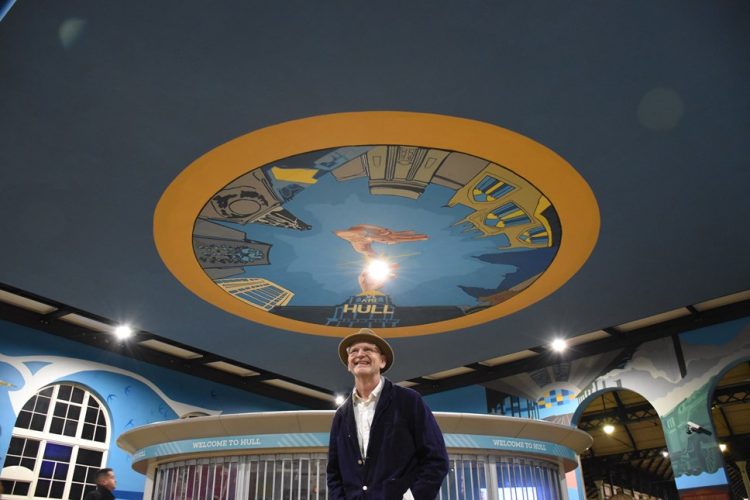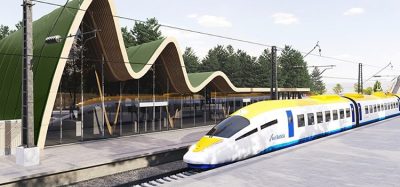TransPennine Express commission majestic art for Hull station
Posted: 24 November 2023 | Emily Budgen | No comments yet
TransPennine Express have commissioned local artist Andy Pea to create a mural, demonstrating the rich history of Hull across the station.


TransPennine Express (TPE) have commissioned a beautiful piece of art for Hull Paragon station. TPE commissioned Hull-based artist, Andy Pea, who, in collaboration with students of Ron Dearing UTC and with ideas from the users of the Interchange and wider public, has created a vibrant public art piece that will serve as a visual chronicle of Hull’s history.
Andy, a practising artist for more than 25 years said: “I’m so proud to be a part of these historic celebrations with TPE and I’m delighted to unveil the finished mural to the people of Hull.
“The ‘Creation of Hull’ artwork aims to enrich the urban landscape, proving that when a community comes together to create, the city flourishes as a canvas for collective expression.”
The artwork provides a kaleidoscope of Hull’s history and culture across four walls and the ceiling of the station entrance with the existing memorial boards in this area will remain and have been sympathetically incorporated into the mural design.
“To see the completed mural in the entrance to the station is fantastic, it’s a true masterpiece and we’re extremely proud to be adding to the rich history of Hull Paragon Interchange,” Chris Jackson, Managing Director at TPE, said.
“Our work won’t stop there though as we are continuing to invest in Hull Paragon Station as part of our blueprint to make journeys better. Replacement benches, new trees for the main concourse areas, permanent Christmas tree and lights and a new digital screen for the Safer Hull Paragon Hub are all planned for the station,” Jackson added.
“In addition, looking beyond 2024, we will be progressing the installation of a second wide gate to the gateline and implementing toilet refurbishment works.”
Hull Paragon users can now see ‘The Creation of Hull’ revealing five chapters on the each of the four walls and ceiling. Those chapters are:
East wall: A tribute to Kingston-Upon-Hull’s deep-rooted connection to the sea and its rich maritime heritage.
South wall: Framed by the Humber Bridge against the backdrop of the estuary, seamlessly fusing the themes of trade and nature.
West wall: A tribute to the vibrant life of Paragon station, a gateway reverberating with echoes of journeys embarked upon and human experiences.
North wall: Representing Hull’s legacy of innovation, through a woven tapestry of inspiration, celebrating the city’s trailblazers who have left an indelible mark on the world.
Ceiling: An imaginative reinterpretation of Michelangelo’s iconic masterpiece ‘The Creation of Adam’, forming the centrepiece of ‘The Creation of Hull’ artwork.
It marks another moment in history for Hull Paragon Interchange, the history of which is being celebrated this week. The first railway station in Hull was built by George Hudson, known as the “Railway King,” and opened in 1840.
As rail travel gained popularity, the original station became inadequate to handle the increasing passenger traffic. In 1847, a larger, more sophisticated station, the one we know today, was opened on the current site. Over the years, several expansions and improvements were made to accommodate the growing demands of the railway network and the city.
In the early 20th century, the station underwent architectural changes, with the construction of a new booking hall and concourse. The station’s façade was redesigned in a neoclassical style, giving it a more imposing and elegant appearance.
Like many other transportation hubs during World War II, Hull Station played a crucial role in the movement of troops and supplies. The station sustained damage during bombing raids, requiring subsequent repairs and renovations.
In the post-war era, the station faced further challenges with the decline in rail travel and the rise of alternative transportation modes. The station underwent changes to adapt to shifting trends, including the introduction of diesel trains.
In the late 20th century and into the 21st century, Hull Station underwent significant modernization efforts. The station was renamed Hull Paragon Interchange to reflect its integration with other transportation modes, such as buses. Upgrades included improved facilities, accessibility, and a shopping centre within the station.
Today, Hull Paragon Interchange stands as a modern transportation hub, connecting rail services with buses and taxis, serving as a gateway to the city and the wider region. The station’s history reflects the evolution of rail travel and its enduring importance in Hull’s transportation infrastructure.
“We’re delighted to support TPE with the 175th anniversary of Hull Paragon Station. The station is so iconic to all of us here at Hull Trains, so much so our trains were proudly named Hull “Paragon” Fleet. This mural has transformed the entrance of the interchange and perfectly captures the essence and history of Hull. It’s a real masterpiece and the perfect way to mark an incredible anniversary for the station,” Louise Mendham, Service Delivery Director at Hull Trains, said.
Earlier this week, TPE marked the 175th anniversary by naming one of its class 185 trains ‘Hull Paragon 175’ in honour of the station. The train will now carry the historic stations name and serve thousands of people as it travels across Yorkshire and the wider TPE network.
More Like This







